TIPWelcome to my CS205 lecture notes! Because the lecture is not in English, I will try my best to translate it.
And at the same time, the
PPT,lab-filealso use the English,I will write the English notes but not all.
NOTEIf you have a passion to konw more about the course, you can click the link below to learn more about the course. Read the repo.
Waiting for api.github.com...
C++ provides two methods to control the output formats
1.1 Using member functions of ios class
1.1.1 cout.setf(): The setf() function has two prototypes,the first one is:
cout.set(fmtflags);

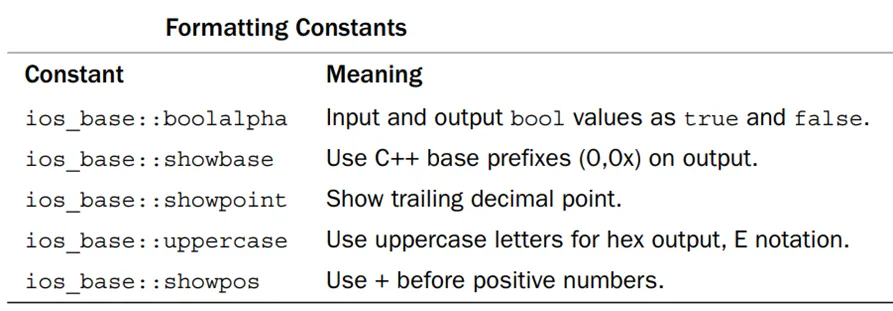
The second one is:
cout.set(fmtflags,fmtflags);
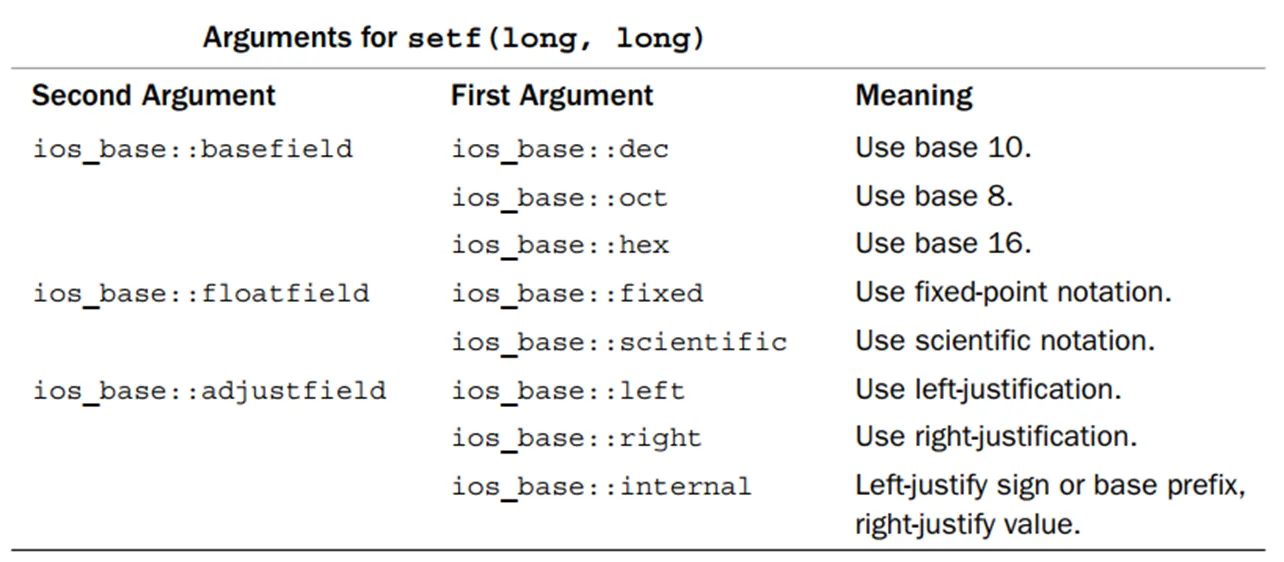
1.1.2. cout.width(len)
1.1.3.cout.fill(ch)
1.1.4.“cout.precision(p)`
#include <iostream>
using namespace std;
int main()
{
//cout.setf(ios_base::fixed, ios_base::floatfield);
cout << 56.8 << endl;
cout.width(12);
cout.fill('+');
cout << 456.77 << endl;
cout.precision(2);
cout << 123.356 << endl;
cout.precision(5);
cout << 3897.678485 << endl;
return 0;
}Output-result:
56.8
+++++456.77
1.2e+02
3897.7[!tip]
we see the
significant digits
Using the ios-class
#include <iostream>
using namespace std;
int main()
{
cout.setf(ios_base::fixed, ios_base::floatfield);
cout << 56.8 << endl;
cout.width(12); //set 12 digits
cout.fill('+'); //fill the '+' in the front of the number
cout << 456.77 << endl;
cout.precision(2);
cout << 123.356 << endl;
cout.precision(5);
cout << 3897.678485 << endl;
return 0;
}Output-result:
56.800000 //normally print the float style
++456.770000//the digits is 12 and fill "+" in not more than 12
123.36
3897.67848TIPwe see the
precision of floating number
C++ offers several manipulators to invoke setf(),automatically supplying the right arguments.
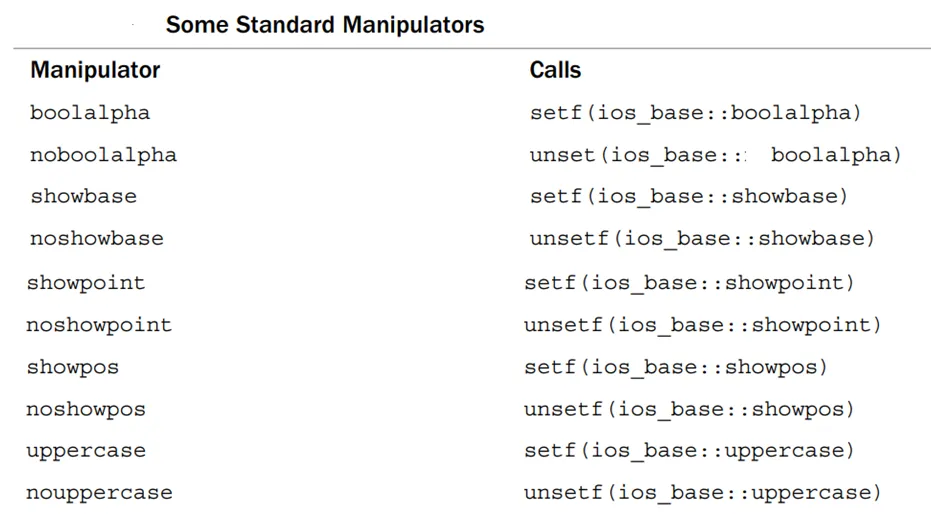
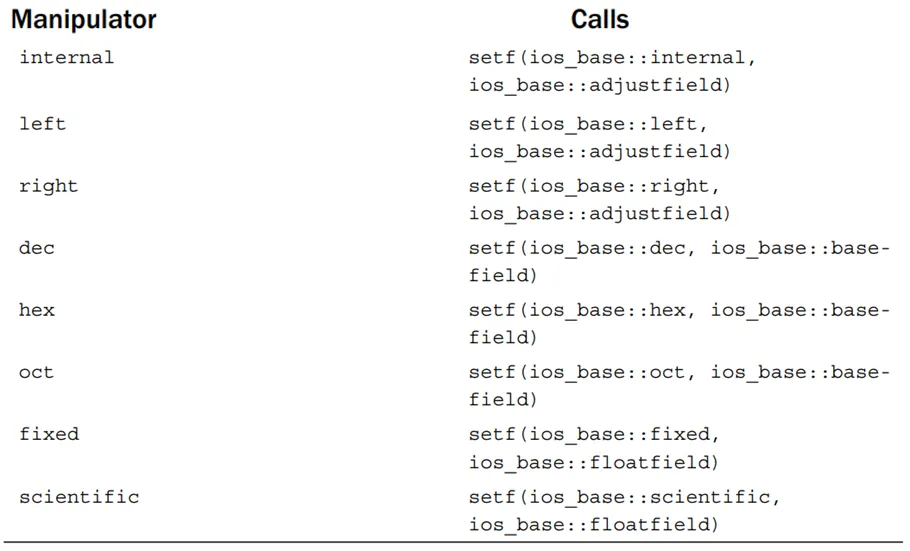
1.2 Using iomanip manipulators
#include <iomanip>
- setw(p) 2. setfill(ch) 3. setprecision(d)
#include <iostream>
#include <iomanip>
using namespace std;
int main()
{
cout.setf(ios_base::fixed, ios_base::floatfield);
cout << 56.8 << setw(12) << setfill('#') << 456.77 << endl;
cout << left;
cout << setw(12) << setprecision(2) << 123.356 << endl;
cout << setw(12) << setprecision(5) << 3897.6784385 << endl;
cout << right;
cout << setw(12) << setfill(' ') << 123.356 << endl;
cout << setw(12) << setfill(' ') << 3897.6784385 << endl;
cout.unsetf(ios_base::fixed);
cout << 56.8 << setw(12) << setfill('$') << 456.77 << endl;
return 0;
}1.3 printf() vs cout
Which one do you prefer?
int a=1234;
float f=123.456;
char ch='a';
printf("%7d,%2d\n",a,a);
printf("%f,%8.1f,%.2f,%.2e",f,f,f,f);
printf("%3c\n",ch);TIP在设定输出格式时,如果并不复杂可以用cout,否则用printf,由于cout和print并不是属于同一个输出流,如果混用会容易超时,所以一般只采用一种输入输出格式。
printf()是C语言的标准输出函数,而cout是C++的标准输出函数。
Debug C/C++ by using gdb in VScode
2.1 Install “gdb” (the debug tool of C/C++)
using cmd “which gdb” to check whether gdb is installed or no
if you wanna update package list,using it:
sudo apt undate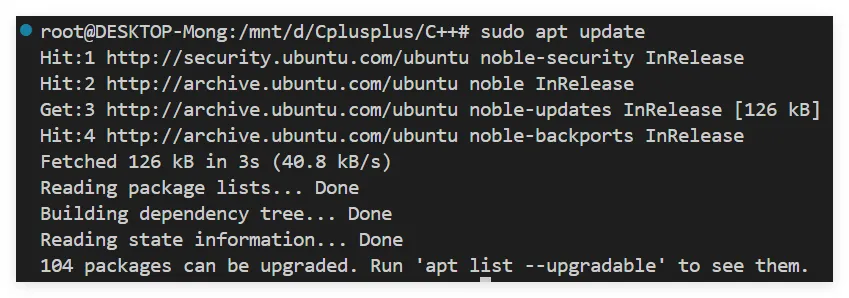
if you wanna insatll gdb, using it:
sudo apt install gdbüIf the installation directory of gdb is displayed after running command “which gdb” is executed, it means that gdb has been successfully installed.
Like:

2.2 configure VSCode for using gdb to debug C/C++ code
create and edit
".vscode"folder and json filescreate a new folder named
".vscode"in the directory of C/C++ codescreate a new json file named
"launch.json"in the “.vscode” folder which is created in step1- edit “launch.json” to set gdb for debugging the execute file which is created by “g++ -g” / “gcc -g”
- tips: option “-g” used with gcc/g++ is to generate information for debugging while compiling the C/C++ source code.
{ "version": "0.2.0", "configurations": [ { "name": "(gdb) Launch", "type": "cppdbg", "request": "launch", "program": "${fileDirname}/${fileBasenameNoExtension}", "args": [], "stopAtEntry": false, "cwd": "${workspaceFolder}", "environment": [], "externalConsole": false, "MIMode": "gdb", "setupCommands": [ { "description": "Enable pretty-printing for gdb", "text": "-enable-pretty-printing", "ignoreFailures": true }, { "description": "Set Disassembly Flavor to Intel", "text": "-gdb-set disassembly-flavor intel", "ignoreFailures": true } ] } ] }
2.3 lunch gdb to debug in VS Code by “Run and Debug”
Compile the source code with “-g” option to generate information for debug and generate the executable file

and you just click here:

2.4 Set “BreakPoint” on source file, lunch gdb to run and debug

2.5 View the data stored in a variable by gdb(optional)
- During debugging, you can use GDB commands to view the data stored in variable(s).
- step1. choose “DEBUG CONSOLE” window.
- step2. run the command in command line in the “DEBUG CONSOLE” window.
- exec [gdb command] in vscode
- step3. View the results after executing the command in the “DEBUG CONSOLE” window.
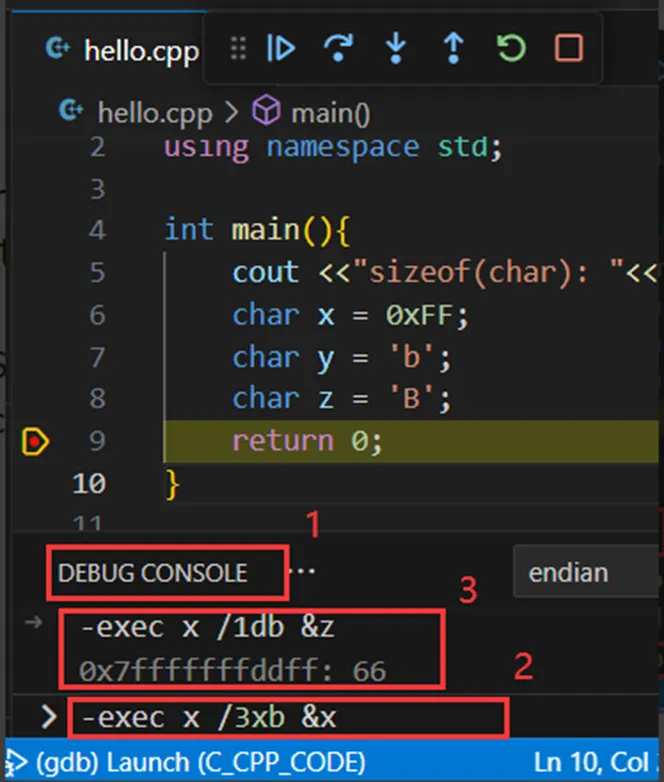
2.6 Examine
Using the command x (for “examine”) to examine memory in any of several formats, independently of your program’s data types.
#include<iostream>
using namespace std;
int main(){
cout<<"sizeof(char:)"<<sizeof char<<" byte(s)"<<endl;
char x=0xFF;
char y='b';
char z='B';
return 0;
}we could use the command to make x equals some variable:
-exec x /1xb &x
0x7fffffffd50d: 0xff
-exec x /1tb &x
0x7fffffffd50d: 11111111
-exec x /1ob &x
0x7fffffffd50d: 0377
-exec x /1db &x
0x7fffffffd50d: -1
-exec x /1ub &x
0x7fffffffd50d: 255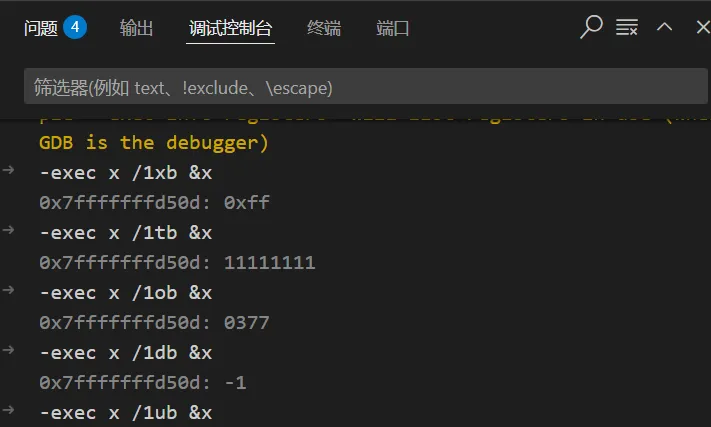
- x /nfu addr
- n, the repeat count
- f, the display format
- u, the unit size
Data type conversions and calculations
3.1 data storage: integer vs float
#include<iostream>
#include<iomanip>
using namespace std;
int main(){
int x=1;
float y=1;
cout<<"sizeof x:"<<sizeof(x)<<" byte(s),"<<"sizeof y"<<sizeof(y)<<" bytes(s)\n";
//如果把它应用于一个类型,必须要像上面所示的那样使用括号,但是如果对一个变量使用它,可以不要括号。
return 0;
}

3.2 Signed vs Unsigned
- Integer promotions of Implicit conversions
#include <stdio.h>
int main(){
char x=0xff;
unsigned char y=0xff;
printf("x: 0x%x, %d , %u\n",x,x,x);
printf("y: 0x%x, %d , %u\n",y,y,y);
printf("x>>2: 0x%x, %d , %u\n",x>>2,x>>2,x>>2);
printf("y>>2: 0x%x, %d , %u\n",y>>2,y>>2,y>>2);
return 0;
}
Exerices
4.1 Compile and run the following program
Whta’s the result?
#include <stdio.h>
int main()
{
signed char a = 127;
unsigned char b = 0x7f;
char c = 0x7f;
a=a<<1;
b=b<<1;
c=c<<1; printf("a=%x\nb=%x\nc=%x\n",a,b,c);
printf("a=%d\nb=%d\nc=%d\n",a,b,c);
a=a>>1;
b=b>>1;
c=c>>1;
printf("a=%x\nb=%x\nc=%x\n",a,b,c);
printf("a=%d\nb=%d\nc=%d\n",a,b,c);
return 0;
}You need to explain the reason to a SA to pass the test.
4.2 Write a program to calculate integer multiplication: 56789 * 23456789
then print the result. Verify the result using a calculator.
If the result is wrong, what could be the reason?
How to get the correct result for this exercise?
It’s my implement of mutiplication: using the long long int,because there’re 32 bit in int type,and the range of the int type is ~ . And there’re 64 bit inlong long int,the MAX value around
4.3 Run the following source code and explain the result.
Then using the method learnt in lecture2 to make the output of the code same as following picture .
#include <iostream> //file name: lab3_p4_3.cpp
using namespace std;
int main()
{
cout << fixed;
float f1 = 1.0f;
cout<<"f1 = "<<f1<<endl;
float a = 0.1f;
float f2 = a+a+a+a+a+a+a+a+a+a;
cout<<"f2 = "<<f2<<endl;
if(f1 == f2) //TIPS: Modify the code here
cout << "f1 == f2" << endl;
else
cout << "f1 != f2" << endl;
return 0;
}
NOTEDO NOT use
if (f1=f2)instead ofif(f1==f2).
**It’s my answer:**When with the float and double type,It’s a matter of accuracy, which means that computers can also deceive humans.
4.4 Complete the following source code to print the variables as the following picture and explain the result.
Why the value of a and b are not equal? Explain the division operation with different types.
You need to explain the reason to a SA to pass the test.
#include <iostream>
using namespace std;
int main()
{
int a, b;
double c, d,f,g;
char h;
a = 19.99 + 21.99;
b = (int)19.99 + 21.99;
c = 23 / 3;
d = 23 / 3.0;
f = 23 / 3.0e4;
g = 23 / 3.0e5;
h = 'b' - 32;
//complete code here
return 0;
}
My answer:
When you use (int)x,it means the x will be explicit conversed to int type,and the 19.99 will be the 19. Different the precision of division will effect on the result.
4.5 What is the output of the code as follows? What is the meaning of auto when defines a variable in C++?
You need to explain the reason to a SA to pass the test.
#include <iostream>
int main()
{
auto a = 10;
a = 20.5;
a += 10.5;
std::cout << a << std::endl;
auto b=10.0;
b = 20.5;
b +=a;
std::cout << b << std::endl;
return 0;
}
My answer:
Because the auto type means automatic recognize the type,and the a is recognized the int,but the b is recogfnized the float,and the different type operation between float and int output the float+
